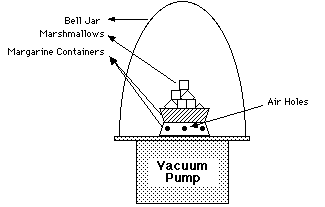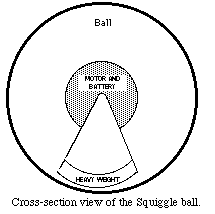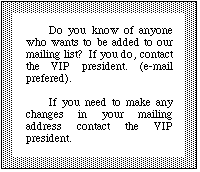|
Virginia
Instructors of
Physics
Volume 8 Number 2
Winter 1994
Contents
Next meeting at JMU (featuring a demonstration of Interactive
Physics)
Briefs from the October VIP meeting
Physics Day at Paramount's King's Dominion (Status Report)
Physics Pavilion Update
Santa Claus and Physics
Squiggle Ball Demo
A demo/lab from the October VIP meeting
Apologies for the short notice on the next meeting. We've
been holding up publishing to hear from PASCO. Sadly they will not be
presenting at the next VIP meeting.
Fall Meeting to be Held at James Madison University on February
26, 1994.
Agenda:
9:00 - 9:30 Hello's
9:30 - 10:30 VIP Business
Future directions of VIP (goals)
10:30 - 11:30 Hand out freebies, demonstrations and lesson plans to
share
Demonstrations will feature some large cart dynamics demo's/labs by
JMU's Dr. Dorn Peterson
11:30 - 1:00 Lunch (You are on your own).
1:00 - 3:00 Demonstration of Interactive Physics II
Notes:
Bring your favorite physics lesson. Bring 50+ copies to handout.
Bring your favorite demonstration. Bring 50+ copies of a write
up.
No registration is necessary.
The meeting is free. Lunch will cost between $4-$6. Non VIP members
are invited to attend for free too.
At the Last Meeting
Did you go to the last meeting? We charted directions for the
Physics Pavilion on Virginia's P.E.N. We traded labs and ideas. We
learned about physics education opportunities. Everyone left with at
Least $10 dollars worth of freebies. Fred Creasy left with a smart
pulley form PASCO. It pays to go to these meetings!
A Few Thanks
Thanks to Dr. B. Deaver and the University of Virginia for sponsoring
the last VIP meeting in October. We also wish to thank them for
footing the bill for these mailings. The Virginia Instructors of
Physics could not operate without their help.
Thanks also go out to Estes Industries and PASCO for donating so many
freebies.
Physics/Science Day at Kings Dominion
by Brion Patterson
For the first time, Paramount's Kings Dominion's Science Day
is scheduled this school year for a weekday! Circle Friday May 27,
1994. The park is at the disposal of only science
and math students. Various aspects of the program are still being
formulated, including possible VQUEST involvement, possible
partnership with math, possible continuation of the Physics Field Day
activities and outside speakers (probably including the Science
Museum and a VMI Physics professor).
The admission price is not settled but is likely to be $15 per
student. the parking is free.
Are you on VaPEN's e-mail yet?
Every educator in Virginia has access to and electronic
information system called Virginia's Public Education Network, VaPEN.
All you need is a computer with a modem, ...any computer brand. A
VaPEN account gives you access to the information highway called
internet. You can send electronic mail, e-mail, to anyone in the
world. Get lesson plans related to USA Today or CNN in your subject
area. Download worksheets, labs, lessons and demonstrations. Read
about current NASA projects. Read press releases about the space
shuttle launches. Download weather satellite images. And much more
...for free!!!
To get a VaPEN account, contact your school division's central office
and they will connect you to the correct people. If that doesn't
work, contact the editor of this newsletter.
VaPEN's Physics Pavilion is On-Line
Sign on to VaPEN. Select the "Academic Village" from the main
menu. Then select Physics Pavilion. You have four options from hear.
Below is an explanation of each option.
Option 1: Read Me First
This section explains the philosophy behind the pavilion,
briefly what is available, and how to contact the curators of the
pavilion.
Option 2: Interactive Resources
This section contains access to physics, space, flight and
science education related newsgroups. There are also connections to
the NEWTON system at UNCG, NEWTON system at Argonne National
Laboratories, and NASA's SpaceLink.
Option 3: Archives
This section contains tests, labs, demos, physics
conversation strings from various newsgroups, public domain, freeware
and shareware software, compilations of frequently asked questions
from various newsgroups, articles on physics and physics related
topics. Everything is organized by computer system and text files.
The text files can be read by everybody and contain the most items.
(We need you contributions to make the archives a big success)
Option 4: Suggestion Box
Drop a note in this suggestion box to contact the curators.
(It is a mail editor.)
What's New?
This is not an option but rather a paragraph explaining
what's new and when the last files were uploaded.
IS THERE A SANTA CLAUS?
by Anonymous
(This article was from a usenet newsgroup off of VaPEN. The return
address of the author was "Santa_Claus.")
1) No known species of reindeer can fly. BUT there are 300,000
species of living organisms yet to be classified, and while most of
these are insects and germs, this does not COMPLETELY rule out flying
reindeer which only Santa has ever seen.
2) There are 2 billion children (persons under 18) in the world. BUT
since Santa doesn't (appear) to handle the Muslim, Hindu, Jewish and
Buddhist children, that reduces the workload to 15% of the total -
378 million according to Population Reference Bureau. At an average
(census) rate of 3.5 children per household, that's 91.8 million
homes. One presumes there's at least one good child in each.
3) Santa has 31 hours of Christmas to work with, thanks to the
different time zones and the rotation of the earth, assuming he
travels east to west (which seems logical). This works out to 822.6
visits per second. This is to say that for each Christian household
with good children, Santa has 1/1000th of a second to park, hop out
of the sleigh, jump down the chimney, fill the stockings, distribute
the remaining presents under the tree, eat whatever snacks have been
left, get back up the chimney, get back into the sleigh and move on
to the next house. Assuming that each of these 91.8 million stops are
evenly distributed around the earth (which, of course, we know to be
false but for the purposes of our calculations we will accept), we
are now talking about .78 miles per household, a total trip of 75-1/2
million miles, not counting stops to do what most of us must do at
least once every 31 hours, plus feeding and etc.
This means that Santa's sleigh is moving at 650 miles per second,
3,000 times the speed of sound. For purposes of comparison, the
fastest man- made vehicle on earth, the Ulysses space probe, moves at
a pokey 27.4 miles per second - a conventional reindeer can run,
tops, 15 miles per hour.
4) The payload on the sleigh adds another interesting element.
Assuming that each child gets nothing more than a medium-sized Lego
set (2 pounds), the sleigh is carrying 321,300 tons, not counting
Santa, who is invariably described as overweight. On land,
conventional reindeer can pull no more than 300 pounds. Even granting
that "flying reindeer" (see point #1) could pull TEN TIMES the normal
amount, we cannot do the job with eight, or even nine. We need
214,200 reindeer. This increases the payload - not even counting the
weight of the sleigh - to 353,430 tons. Again, for comparison - this
is four times the weight of the Queen Elizabeth.
5) 353,000 tons traveling at 650 miles per second creates enormous
air resistance - this will heat the reindeer up in the same fashion
as spacecraft reentering the earth's atmosphere. The lead pair of
reindeer will absorb 14.3 QUINTILLION joules of energy. Per second.
Each. In short, they will burst into flame almost instantaneously,
exposing the reindeer behind them, and create deafening sonic booms
in their wake. The entire reindeer team will be vaporized within 4.26
thousandths of a second. Santa, meanwhile, will be subjected to
centrifugal forces 17,500.06 times greater than gravity. A 250-pound
Santa (which seems ludicrously slim) would be pinned to the back of
his sleigh by 4,315,015 pounds of force.
In conclusion - If Santa ever DID deliver presents on Christmas Eve,
he's dead now.
...from people who got coal in their stockings last year.

Pressure Demonstration/Density Lab
Performed by Jackie Hardie at the last VIP physics meeting.
written by Tony Wayne
Assemble the materials as shown to the right. When you evacuate the
air the marshmallows will expand -they are mostly whipped up sugar.
For a more dramatic effect replace the marshmallows with shaving
cream. But do not use much. the shaving cream will expand much more
than the marshmallows.

The Density Lab
Have the students mass out a marshmallow. Now students
calculate the volume of the marshmallow before they are put in the
vacuum jar. To measure the volume, pour 50 ml of sand in a graduated
cylinder. Put the marshmallow in the another cylinder. Pour the sand
over the marshmallow. The difference in volume is due to the volume
of the marshmallow. clean the marshmallow. Put it in the vacuum jar.
Evacuate the jar's air. Then measure the density again.
Squiggle Ball Demo
by Tony Wayne
Have you seen a ball in the toys stores call the Squiggle Ball ? The
ball rolls around endlessly with no visible power source. If the ball
gets stuck in a corner it wiggles until it gets loose. This makes a
great demonstration. It works similar to the "Come Back Can demo."
The motor tries to spin the weight around the a center shaft. The
inertia of the mass is much greater than the inertia of the ball
shaped shell. Therefore the ball rolls around the hanging weight. You
could also describe this as a dynamic situation where the energy is
trying to remain in the lowest state.

As the weight rotates up the ball rolls. Trading off potential energy
for kinetic. How is this the lowest state? If the ball does not roll,
the weight will be raised higher and the system, will have more
energy than if the ball rolls as the weight is raised.
The next issue will feature:
VaPEN's Physics Pavilion's Content Highlights
Summer Projects
Brion Patterson's Low Cost Optical Telecommunications Demonstration
(shown at the last VIP meeting).
How to Make a Digital Timing System for About $15 a Station Instead
of $300.
Please send the editor your great ideas to be published. Get
recertification credit for being published and presenting at VIP
meetings! The next newsletter should arrive in early June. Submit
ideas by May 1, 1994.

VIP Officers
President: Tony Wayne
Albemarle High School
2775 Hydraulic Road
Charlottesville, VA 22901-8916
e-mail:
Vice President: Brion Patterson,
Rappahannock Co. High School
Sperryville, VA 22740
e-mail:
Secretary: Frank Anderson
Woodbeery Forest
Physics Pavilion
Curators: Tony Wayne
Albemarle High School
2775 Hydraulic Road
Charlottesville, VA 22901-8916
e-mail:
and
Fred Hoffman
Roanoke Valley Governor's School
2104 Grandinheck
Roanoke, VA 24015
email:
Publisher: Dr. Bascom Deaver
Physics Department
Jesse Beams Laboratory
University of Virginia
McCormick Road
Charlottesville, VA 22901
Newsletter Editor: Tony Wayne
Albemarle High School
2775 Hydraulic Road
Charlottesville, VA 22901-8916
e-mail:
|